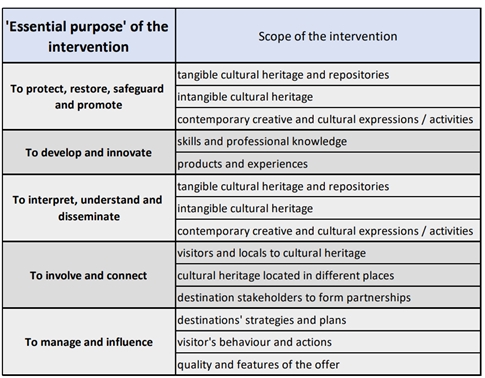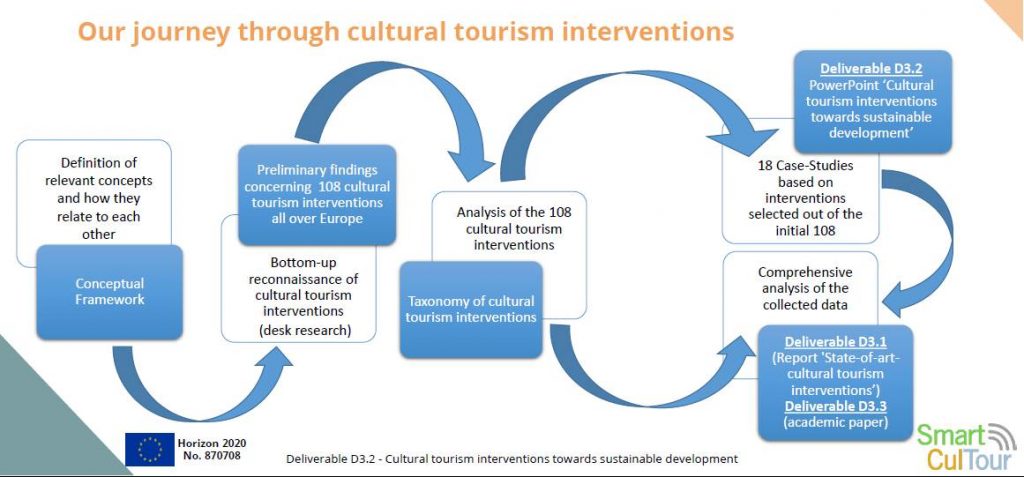By pursuing different interests and objectives, cultural tourism stakeholders determine a wide range of impacts on tourism destinations and their communities. For instance, private businesses are constantly investing resources (time, money, expertise, skills, etc.) to innovate the cultural tourism offer, determining multiple socio-economic impacts. Destinations can embrace a variety of governance settings and influence the decisions of public or private actors. Moreover, local and national governments, the European Union and other international organisations often grant financial resources for a wide range of programs and projects, aiming at uncovering, designing and implementing more sustainable forms of cultural tourism. Such a complex range of activities and the diverse spectrum of actors involved, stress the urgency to gather and frame more structured insights on what the impacts and success conditions of these initiatives and approaches are. Within SmartCulTour, the objective of Work Package 3 is to provide a ‘state-of-the-art’ of cultural tourism interventions implemented in European cities and regions, thereby identifying good practices and their impacts and success conditions. We are pursuing this objective via a multiple-steps approach:
- The contribution of SmartCulTour partners allowed to collect preliminary insights concerning the context, actors, objectives and impacts of more than 100 interventions all over Europe. This revealed information about interventions initiated by different stakeholders, ranging from national and local governments to private businesses or NGOs. The variety of cultural tourism interventions that have been considered includes the introduction of new cultural products, marketing and communication activities, heritage interpretation, capacity building, visitor management plans and regulations, just to mention some examples. The gathered data also revealed preliminary insights on the impacts of the interventions in terms of social, economic and environmental sustainability of the destinations and the resilience of their communities. Focusing on the essential purpose of the interventions, the analysis of the collected data allowed to propose the following innovative taxonomy of cultural tourism interventions:

- Starting form the proposed taxonomy and supported by a process of expert’s evaluations, we selected 18 interventions (out of the initial 108), to be further investigated via in-depth case studies. Aiming at interviewing at least 3 relevant stakeholders, each case study allowed to enrich the available data, especially concerning the economic, socio-cultural and environmental impacts of the interventions, revealing additional insights in terms of success conditions and “lesson learnt” from these interventions.
- SmartCulTour Deliverable D3.2, available here, contains a ‘portfolio’ with the 18 selected interventions, reporting essential information about the context, the initiators, the required resources, the impacts, success conditions and lesson learnt through the interventions. This selection of cases reflects the variety of interventions analysed, ranging from the development of entrepreneurial ideas to initiatives focused on interpreting the heritage of minorities or capacity building projects and initiatives that provided a common space, where the tourism and culture industries could meet, discuss and work with each other.
- By the end of May 2021, also the SmartCulTour deliverable D3.1 will be available here, providing a comprehensive state-of-the-art of cultural tourism interventions implemented in European cities and regions, with an overview and additional insights on good practices, impacts and success conditions of cultural tourism interventions.
The outcomes of this process will be useful as a reference about the state-of-art of cultural tourism interventions in Europe and can be used to initiate and structure discussions concerning cultural tourism and sustainable development in a variety of urban and regional settings.


